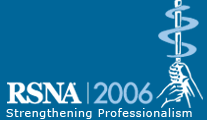
Abstract Archives of the RSNA, 2006
SST06-04
Noninvasive Evaluation of Coronary Artery Plaques and Stenoses by 64-slice CT Angiography
Scientific Papers
Presented on December 1, 2006
Presented as part of SST06: Cardiac (CT)
Yining Wang MD, Presenter: Nothing to Disclose
Zheng Yu Jin, Abstract Co-Author: Nothing to Disclose
Lingyan Kong MD, Abstract Co-Author: Nothing to Disclose
Reto Dominik Merges, Abstract Co-Author: Employee, Siemens AG, Forchheim, Germany
Shuyang Zhang MD, Abstract Co-Author: Nothing to Disclose
Songbai Lin, Abstract Co-Author: Nothing to Disclose
To evaluate the potential of 64-slice MSCT to assess coronary plaque and detect coronary artery stenoses. We also investigated the relationship between plaque burden and significant stenoses.
74 patients (47 male, 27 female; age 61±11 years) with suspected coronary artery disease (CAD) underwent both ECG-gated CT angiography (CTA) (120kV, 850mAs, 0.33 s-rotation time, 64 x 0.6 mm collimation,Siemens Somatom Sensation 64) and conventional quantitative coronary angiography (QCA). For all the patients the Agatston Score was determined using syngo CaScoring and graded on a 4-point scale from none (0) to severe calcification (3). The total number of non-calcified plaques was calculated for each patient. All coronary segments were assessed for significant stenoses (>50% diameter reduction) using syngo Circulation software and the total number of significant stenoses was calculated for each patient.
Images of all patients showed diagnostic image quality. 1070 of 1110 (96%) segments were assessable. QCA found overall 150 significant stenoses. 143 of these were detected on CTA: 69 (48%) non-calcified plaques, 13 (9%) calcified plaques and 61 (43%) mixed plaques (42 non-calcified dominant and 19 calcified dominant plaques). Totally 111 (78%) significant stenoses were accompanied by non-calcified dominant plaques and 32 (22%) by calcified dominant plaques. The Spearman correlation coefficient between significant stenoses and calcium burden was 0.65 (P<0.01), between significant stenoses and non-calcified plaque burden 0.91 (P<0.01). Sensitivity, specificity, and positive and negative predictive values of 64-slice MSCT for classifying significant stenoses were: 94%, 98%, 90%, and 99%, respectively.
64-slice MSCT allows non-invasive detection of coronary artery stenoses with high accuracy. Total calcium burden and non-calcified plaque burden have a close correlation to significant stenoses, the latter one with a higher correlation coefficient.
64-slice CTA is equivalent to QCA in detecting coronary artery stenoses and can identify coronary plaques as calcified and non-calcified. It is recommended in the initial evaluation of suspected CAD.
Wang, Y,
Jin, Z,
Kong, L,
Merges, R,
Zhang, S,
Lin, S,
Noninvasive Evaluation of Coronary Artery Plaques and Stenoses by 64-slice CT Angiography. Radiological Society of North America 2006 Scientific Assembly and Annual Meeting, November 26 - December 1, 2006 ,Chicago IL.
http://archive.rsna.org/2006/4435889.html

